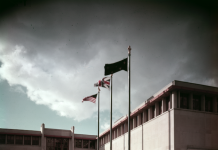1968 For over 100 years, motorboat racing on the Detroit River has been a celebrated summer tradition, with the Gold Cup at the center of it.
The prestigious event came to the Motor City in 1916, a year after Jack Beebe and John Milot piloted the community-owned Miss Detroit to win the 1915 Gold Cup race in upstate New York. After that, Detroit became the boat-racing capital of North America and hosted the Gold Cup 53 times, consecutively from 1990 through 2014 and most recently in 2018.
Two of the most famous local racers were boat manufacturer Gar Wood, who won the Gold Cup in Detroit for five consecutive years (1917 to 1921), and Royal Oak native Bill Muncey, an eight-time Gold Cup champion who won the fabled trophy twice in Detroit (1956 and 1972).
When an up-current wind on June 30 and July 1, 1968, resulted in high waves and dangerous conditions, the Gold Cup race was rescheduled to Sept. 8.
With the Detroit Edison Conners Creek power plant and its iconic вҖңSeven SistersвҖқ and вҖңTwo BrothersвҖқ smokestacks in the background, two thunderous unlimited hydroplanes are pictured above roaring down the front stretch that day.
Thousands of enthusiastic fans viewed the famous race from numerous vantage points, including Waterworks Park, the shores of Belle Isle, the Detroit Yacht Club, and the Roostertail and SindbadвҖҷs restaurants.
Billy Schumacher, driving Miss Bardahl on the five-lap, 3-mile course, won the вҖҷ68 Gold Cup with an average speed of 111 mph, but the race was marred by a dramatic crash near the Detroit Yacht Club when Miss Eagle Electric, driven by Warner Gardner, caught a wave going 160 mph, sailed into the air, slammed into the water, and exploded into pieces. The former World War II flying ace died 24 hours later from his injuries. Drivers consider the Detroit River and its unpredictable sudden swells as one of the most dangerous unlimited hydroplane courses.
The Conners Creek power plant and the вҖңSeven SistersвҖқ smokestacks were constructed between 1915 and 1921. Along with the вҖңTwo BrothersвҖқ smokestacks added in 1951, they became favorite navigational landmarks for boaters and pilots.
The original plant and вҖңSeven SistersвҖқ were taken offline in 1988 and demolished in 1996. The remaining plant and вҖңTwo BrothersвҖқ were decommissioned in 2008 and demolished in 2019 to make way for the expansion of ChryslerвҖҷs Jefferson North assembly plant.
This story originally appeared in the July 2024 issue of ПгёЫБщәПІКНјҝвЧКБП magazine. To read more, pick up a copy of ПгёЫБщәПІКНјҝвЧКБП at a local retail outlet. Our digital edition will be available on July 8.
|
| Мэ |
|








